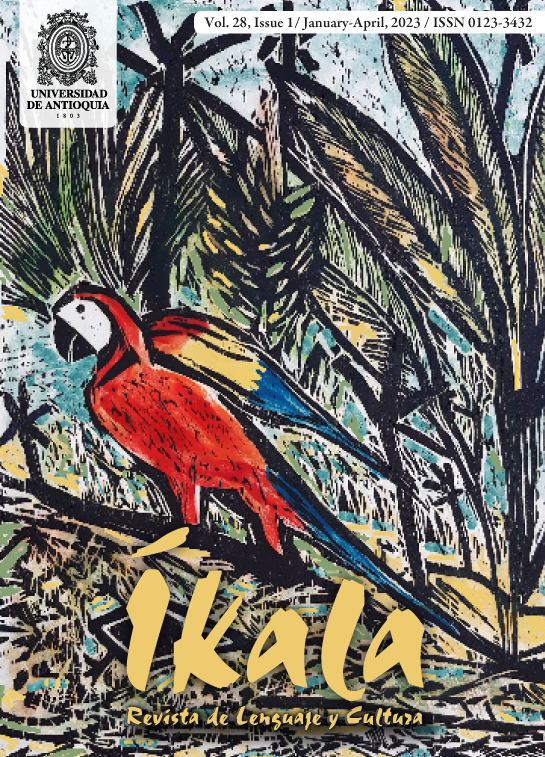El lenguaje de las criptomonedas: palabras frecuentes, neologismos, acrónimos y metáforas
DOI:
https://doi.org/10.17533/udea.ikala.v28n1a07Palabras clave:
Criptomoneda, Cripto-lenguaje, Lenguaje financiero, Análisis del lenguaje, Bit2MeResumen
Las criptomonedas han sido la última revolución tecnológica en el mundo de las finanzas. Aunque esta revolución aún no se ha completado, y su uso para pagar cosas aún es muy limitado, su popularidad ha aumentado enormemente desde 2020 debido a la especulación sobre su valor. Como en cualquier otro campo, cualquier revolución económica, tecnológica, educativa o social implica otra revolución lingüística paralela. La comunicación y el lenguaje han evolucionado con la invención de nuevas cosas e ideas. Es así como la introducción de las criptomonedas ha conllevado la creación de algunas nuevas formas de lenguaje. El objetivo de este estudio de caso cuantitativo es analizar las características de ese lenguaje criptográfico e identificar algunas de las palabras, siglas, metáforas y otras expresiones populares más habituales dentro de este campo. Para cumplir con este propósito, en esta investigación se utilizaron las palabras incluidas en un glosario creado por Bit2Me. Su uso se calculó después de buscar esas palabras con la barra de búsqueda de Google e identificar el número de apariciones en la red. Los resultados mostraron que se habían creado algunos neologismos, las siglas prevalecían sobre las palabras que representaban su significado y el uso de metáforas de animales era una práctica habitual. Estos resultados son una contribución al campo de las finanzas electrónicas ya que demuestra que la comunidad de usuarios de criptomonedas ha creado sus propias reglas lingüísticas para comunicarse entre ellas usando términos específicos, como se detalla en este artículo.
Descargas
Citas
Algeo, J. (1977). Blends, a structural and systemic view. American Speech, 52(1), 47-64. https://doi.org/10.2307/454719
Aronoff, M. (1976). Word formation in generative grammar. Linguistic Inquiry Monographs Cambridge, Mass, 1(1), 1-134.
Bhatia, V. K. (1997). Applied genre analysis and esp. In T. Miller (Ed.), Functional approach to written text: Classroom applications, (pp. 134-149). Information Agency.
Bhatia, V.K. (2004). Worlds of written discourse: A genre-based view. Continuum International.
Cheng, W., & Ho, J. (2017). A corpus study of bank financial analyst reports semantic fields and metaphors. International Journal of Business Communication, 54(3), 258-282. https://doi.org/10.1177/2329488415572790
Ciganović, B. (2019). A study of the cryptocurrency terminology in English and Croatian (Doctoral dissertation). Josip Juraj Strossmayer University of Osijek.
Crystal, D. (2001). Language and internet. Cambridge University Press. https://doi.org/10.1017/CBO9781139164771
Dyer, A. W. (1989). Making semiotic sense of money as a medium of exchange. Journal of Economic Issues, 23(2), 503-510. https://doi.org/10.1080/00213624.1989.11504916
Furnham, A. (1984). Many sides of the coin: The psychology of money usage. Personality and individual differences, 5(5), 501-509. https://doi.org/10.1016/0191-8869(84)90025-4
Gaudio, P. (2012). Incorporation degrees of selected economics-related Anglicisms in Italian. The anglicization of European Lexis, 10, 305-324. https://doi.org/10.1075/z.174.20gau
Gibbs, R. (1994). The poetics of mind: Figurative thought, language, and understanding. Cambridge University Press.
Harley, H. (2006). English words: A linguistic introduction. Blackwell.
Janssen, M. (2005). Between inflection and derivation paradigmatic lexical functions in morphological databases. In J. D. Apresjan & L. L. Iomdin (Eds.), East-West encounter: Second International Conference on Meaning and Text Theory (pp. 187–196). Slavic Culture Languages.
Khan, M. (2013). Neologisms in Urdu: A linguistic investigation of Urdu media. Language in India, 13(6), 816-826.
Klebanow, S. (1991). Power, gender, and money. In S. Klebanow, and E. L. Lowenkopf (Eds.), Money and mind (pp. 51-59). Springer. https://doi.org/10.1007/978-1-4615-3762-5_5
Krimpas, P. G. (2017). iso 704: 2009 and equivalents of English financial terms in lesser-used languages: The case of Greek. Perspectives, 25(3), 397-416. https://doi.org/10.1080/0907676X.2017.1287206
Lakoff, G, & Johnson, M. (1980). Metaphors we live by. Chicago University Press.
Laursen, A. L., & Mousten, B. (2015). Tracking anglicisms in domains by the corpus-linguistic method—A case study of financial language in stock blogs and stock analyses. In ieee International Professional Communication Conference, (pp. 1-7). Institute of Electrical and Electronics Engineers. https://doi.org/10.1109/IPCC.2015.7235806
Lipton, A. (2019). Toward a stable tokenized medium of exchange. In C. Brummer (Ed.), Cryptoassets. Legal, regulatory and monetary perspectives (pp. 89-115). Oxford. https://doi.org/10.1093/oso/9780190077310.003.0005
Mateo-Martinez, J. (2010). Professional and academic languages. In R. Giménez Moreno (Ed.), Words for working professional and academic English for international business and economics (pp. 17-56). Universitat de València.
Nădrag, L. (2020). How to teach English for economics. Case study: Cryptocurrency and Bitcoin vocabulary. Ovidius University Annals, 20(1), (Series Economic Sciences), 444-450.
Nakamoto, S. (2019). Bitcoin: A peer-to-peer electronic cash system. Manubot, 1-7. Retrieved on 31 May 2020 from https://bitcoin.org/bitcoin.pdf
Peprnik, J., & Univerzita Palackého (2006). English lexicology. Univerzita Palackého v Olomouci.
Plag, I. (2003). Word-formation in English. Cambridge University Press. https://doi.org/10.1017/
CBO9780511841323
Rao, X. N. (2008). A study on business text translation from the perspective of translation aesthetics. Wuhan University.
Ratih, E., and Gusdian, R. (2018). Word formation processes in English new words of Oxford English Dictionary (OED) online. Celtic: A Journal of Culture, English Language Teaching, Literature and Linguistics, 5(2), 24-35. https://doi.org/10.22219/celtic.v5i2.7617
Sánchez-Pérez, M., & Cortés-de-los-Ríos, M. E. (2015). The financial language used to communicate the same socio-economic events in English and Spanish press through metaphors and metonymies. ESP Today, 3(2), 216-237.
Silaški, N. (2011). Animal metaphors in some business-related terms in English. Radovi Filozofskog fakulteta u Istočnom Sarajevu, 13(1), 565-576.
Somit, A. (1948). Andrew Jackson as administrator. Public Administration Review, 8(3), 188-196.
Ten Hacken, P., & Thomas, C. (2013). The semantics of word formation and lexicalization. Edinburgh University Press. https://doi.org/10.3366/edinburgh/9780748689606.001.0001
Trask, R. L. (1999). Key concepts in language and linguistics. Psychology Press.
VanPatten, B. (2011). Stubborn syntax: How it resists explicit teaching and learning. In P. Leow and Sanz, C. (Eds.), Implicit and explicit language learning: Conditions, processing, and knowledge (pp. 9-21). Georgetown University.
Worster, D. (1993). The wealth of nature: Environmental history and the ecological imagination. Oxford University Press.
Wallace, N. (2010). Fiat money. In S. N. Durlauf & L. E. Blume (Eds.), Monetary Economics (pp. 66-75). Palgrave Macmillan. https://doi.org/10.1057/9780230280854_8
Descargas
Publicado
Cómo citar
Número
Sección
Categorías
Licencia
Derechos de autor 2022 Íkala, Revista de Lenguaje y Cultura

Esta obra está bajo una licencia internacional Creative Commons Atribución-NoComercial-CompartirIgual 4.0.












